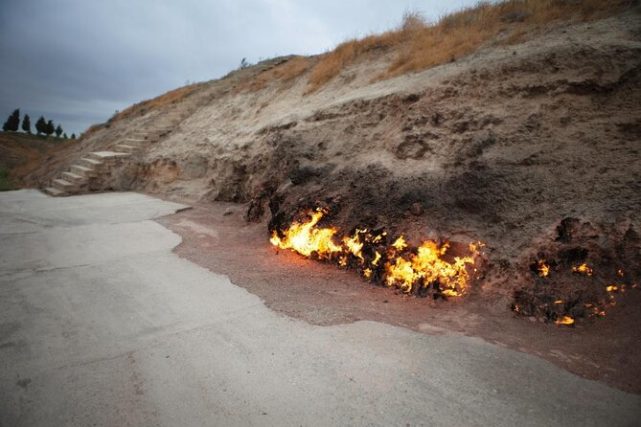A side effect of the country’s abundant natural gas reserves, wildfires have fascinated and scared travelers over the millennia. (Credit: Reproduction/Social Network)
“This fire burned for 4,000 years and never stopped,” says Aliyeva Rahila, a tour guide for Azerbaijan. “Even the rain coming here, snow, wind – it never stops burning.”
Ahead, soaring flames dance relentlessly across a 10-meter stretch of hillside, making a hot day even hotter. This is Yanar Dag – which means “mountain on fire” – on Azerbaijan’s Absheron Peninsula, where Rahila works.
+ Fire hits forest in Copacabana; flames may have started with fireworks
A side effect of the country’s bountiful natural gas reserves, which sometimes leak to the surface, the Yanar Dag is one of several wildfires that have fascinated and terrified travelers to Azerbaijan over the millennia.
Venetian explorer Marco Polo wrote about the mysterious phenomena when he passed through the country in the 13th century. Other Silk Road traders brought news of the flames as they traveled to other lands.
This is why the country has earned the nickname “Land of Fire”.
ancient religion
These fires were once rife in Azerbaijan, but because they led to a reduction in gas pressure underground, interfering with commercial gas extraction, most have been extinguished. Yanar Dag is one of the few remaining examples and perhaps the most impressive.
At the same time, they played a key role in the ancient Zoroastrian religion, which was founded in Iran and flourished in Azerbaijan in the 1st millennium BC.
For Zoroastrians, fire is a link between humans and the supernatural world, and a medium through which spiritual insight and wisdom can be gained. It is cleansing, life-sustaining, and a vital part of worship.
Today, most visitors to Yanar Dag’s simple visitors’ center come for the spectacle rather than the religious achievement.
The experience is most impressive at night or in winter. When snow falls, the flakes dissolve in the air without ever touching the ground, says Rahila.
Despite the alleged antiquity of the Yanar Dag flames – some argue that this particular fire may have only been started in the 1950s – it’s a long 30-minute drive north of central Baku just to see it. The center only offers a small cafe and there’s not much else in the area.
Ateshgah Fire Temple
For a deeper look into Azerbaijan’s fire worship history, visitors should head east from Baku to the Ateshgah Fire Temple.
“Since ancient times they have thought that [seu] god is here”, says our guide, as we enter the pentagonal complex that was built in the 17th and 18th centuries by Indian settlers in Baku.
Fire rituals at this site date back to the 10th century or earlier. The name Ateshgah comes from the Persian for “house of fire” and the centerpiece of the complex is a domed altar shrine built over a natural gas vent.
A natural, eternal flame burned here on the central altar until 1969, but nowadays the fire is powered by Baku’s main gas supply and is lit for visitors only.
The temple is associated with Zoroastrianism, but it is as a place of Hindu worship that its history is best documented.
merchants and ascetics
Built as a caravanserai-style traveler’s inn, the complex has a walled courtyard surrounded by 24 cells and rooms.
These were used in various ways by pilgrims, passing merchants (whose donations were a vital source of income) and resident ascetics, some of whom subjected themselves to such ordeals as lying in caustic quicklime, wearing heavy chains, or keeping one arm in a position for years. At the end.
The temple fell out of favor as a place of worship in the late 19th century, at a time when the development of the surrounding oil fields meant that Mammon veneration was gaining momentum.
The complex became a museum in 1975, was named a UNESCO World Heritage Site in 1998, and today welcomes around 15,000 visitors a year.
#Eternal #Flame #fire #burned #nonstop #years









